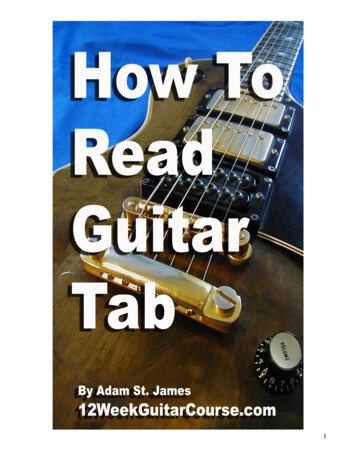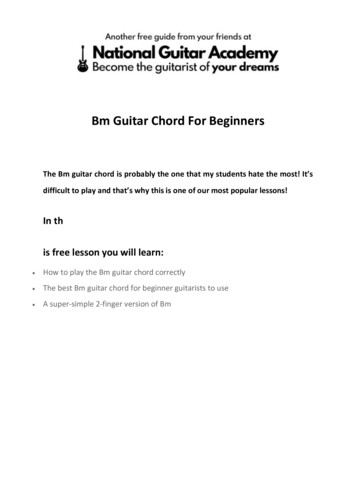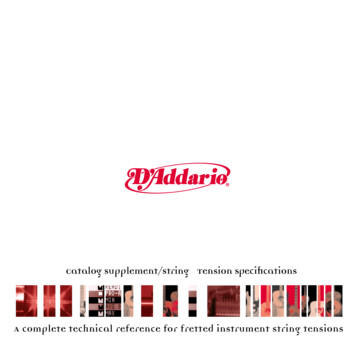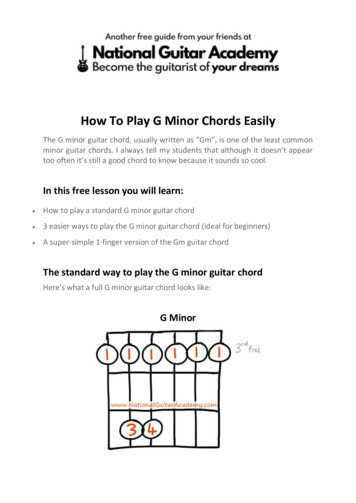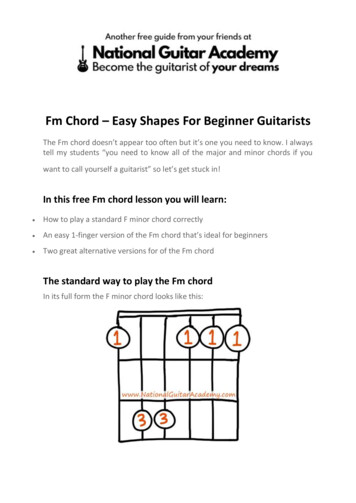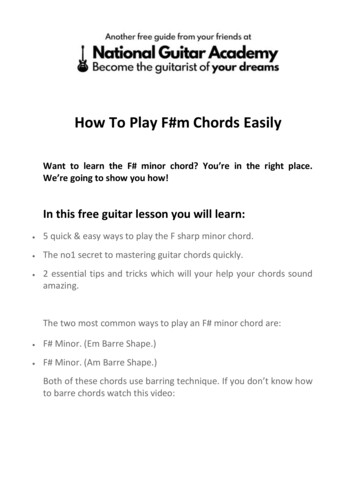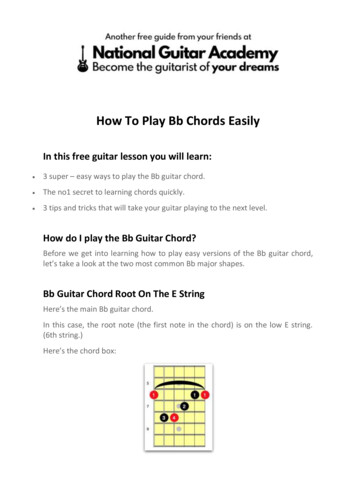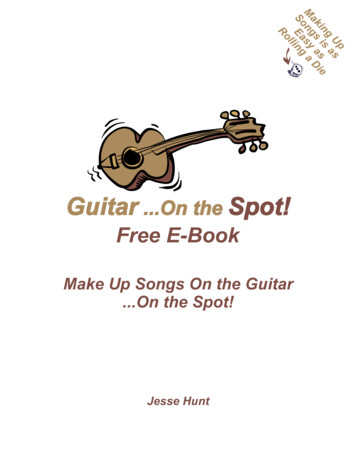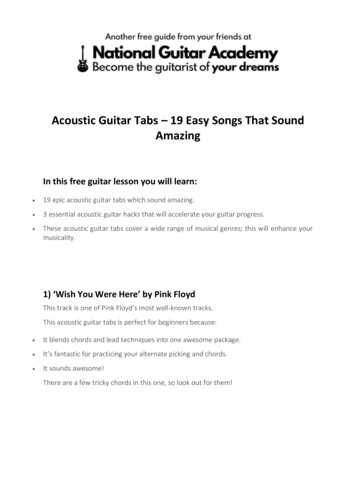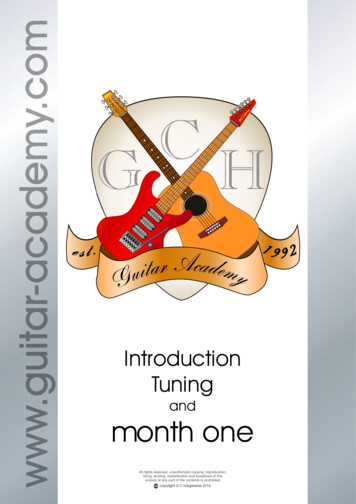
Transcription
IntroductionTuningandmonth oneAll rights reserved, unauthorized copying, reproduction,hiring, lending, redistribution and broadcast of thise-book or any part of the contents is prohibited.copyright G C Hargreaves 2016
Month OneIntroductionWeek oneOpen Chords & exercisesAmazing Grace - traditional gospelDown in the valleyWeek twoHey Jude - the BeatlesG major scaleWeek threeLive forever - OasisG minor naturalWeek FourCandle in the wind - Elton JohnG minor pentatonicBackings01 Around the mountain02 Hey Jude03 Amazing grace04 Live forever05 Candle in the windMonth TwoWeek oneReading tablatureTablature exercisesWeek twoThe Basic BluesGhost riders in the sky - Duane EddyWeek threeF Half barre chordsFree Bird - Lynard Skynardin the wind - Bob DylanWorking on the highway - B SpringsteenWeek fourMixolydian ScaleG minor natural scaleG blues scaleThe A blues scaleBackingsMonth Three06 The basic blues07 Free Birdin the wind0809 Working on the HighwayMonth FourWeek oneNotes on the E stringSharps and FlatsMaggie May - Rod StewartWeek twothemetheme, acoustic versionWeek threeThe B major chordPaint it blackWeek fourImprovisation oneRumble - Link WrayWeek oneE string rooted barre chordsExercisesWeek twoHere come the rain again -- The EurythmicsWeek threeA shaped half barre chordsNights in white satin - Justin HaywoodWeek fourNotes on the A stringA string rooted barre chordExercisesRent - The Petshop boysBackingsBackings10 Maggie May11 Crockets theme12 Crockets theme (acoustic)13 Paint it black14 Basic blues (with guitar)Month FiveWeek oneYesterday - The BeatlesChord theory one, major/minor chordsWeek twoRhythm techniquesKnocking on heavens door - Bob DylanLinger - The CranberriesWeek threeRepeats and terminalsHey Jude (with rhythm) - The BeatlesExercisesWho is like thee O Lord - Jewish FolkWeek fourSpace oddity - David bowieWe are the People - Empire of the sunAbout a girl - NirvanaBackings15 Here comes the rain again16 Nights in white satin17 RentMonth SixWeek oneRock exercisesRock and grunge techniquesWeek twoRock exercisesSmoke on the water - Deep PurpleWeek threeon a prayer - Bon JoviGrunge Punk exercisesWeek fourSmells like teen spirit - NirvanaBackings18 Yesterday19 Knocking on heavens door20 Linger21 Who is like thee O Lord22 Space oddity23 We are the people24 About a girlcopyright G C Hargreaves 201625 Smoke on the wateron a prayer2627 Smells like teen Spirit
Month SevenWeek oneCountry exercisesHurt - Johnny CashWeek twoCountry exercises 2I walk the line - Johnny CashWeek threeReggae / Ska exercisesRed red wine - UB40Week fourReggae / Ska exercises 2I shot the sheriff - Bob MarleyBackingsMonth EightWeek oneBlues exercisesWeek twoSteam roller - James TaylorWeek threeBlues scale exerciseImprovisation revisionWeek fourBasic blues chordsChord theory two - seventh chordsBackings28 Hurt - Johnny Cash29 I walk the line30 Reggae drum beats31 Red red wine - UB4032 I shot the sheriffMonth NineWeek oneFinger picking basicsExercises PIMIPicking DuetWeek twoRain - Sad FantasyWeek threeIntroduce the annular fingerExercisesNights in white satin - Justin HaywardWeek fourAlternating bass lineExercisesEverybody hurts - REMBackingsMonth TenWeek oneAlternating bass line exerciseWeek twoExerciseHouse of the rising sun - The AnimalsWeek threeBlocking exercisesWeek four4/4 time exercisesNowhere man - The BeatlesBackings39 House of the rising sun40 Nowhere man36 Duet37 Nights in white satin (pick)38 Everybody hurtsMonth TwelveMonth ElevenWeek oneFifth chord theory & exercisesThe slur symbolPoly - NirvanaWeek twoHammering onExercisesParanoid - Black SabbathWeek threePulling offExercisesManic depression - Jimi HendrixWeek fourPicking directionsExercisesZombie - The CranberriesBackings33 Steam roller34 Blues improvisation 135 Blues improvisation 241 Polly42 Paranoid43 Manic depression44 ZombieWeek oneReading rhythm & exercisesTime signaturesSan Francisco - Scott McKenzieWeek twoBendsHouse of the Rising Sun (Lead)Summer time (lead)Wonderful tonight - Eric ClaptonWeek threeSecond blues scaleImprovisation twoStaccato and mutesWeek fourWonderful land - The ShadowsAppendixBackingscopyright G C Hargreaves 2016Chords and scales45 San Francisco - Scott McKenzie46 Wonderful tonight47 Blues improvisation 348 Blues improvisation 449 Theme to young lovers50 Wonderful land
IntroductionIn order for any guitar course to be successful,you must practise.practise practise practise practise practise practiseGetting startedmachineheadsortuning pegstop nutfretsneck and fingerboardposition markersbodyrosettesound holepickupsscratch platetailpiece and bridgestrap buttoncopyright G C Hargreaves 2016
Headstockmakers logomachinehead(whole mechanism)capstonstuning pegsstring tree(string retainer)truss rod accesstop nutfretsfingerboardfingering mapxtop nutstring shouldnot be playedfretsstringsleft handfinger placedbetweenthe frets1Left handfinger numberfret mapEBGDAEFGACDEAFBCEFGBCDEFGABCcopyright G C Hargreaves 2016
Tuningif it is out of tune. As time goes by you will start to recognize when your guitar is out of tune yourself.IMPORTANT NOTES ON TUNINGIf it is possible, get someone with experience to tune your guitar for the first few times. This will give you timeto become accustomed to the sound of the instrument when it is in tune before you attempt to tune ityourself.When tuning your guitar remember to turn the tuning pegs by very small amounts and then re-pluck thepluck the string before turning the tuning pegs, so you can hear the effect it is having on the pitch.Listen for the pitch of the string, not the tone. This can cause confusion because the string you are tuningand the reference note may sound different, even though they are in tune with one another.Tuning to reference notesUsing a reference note is the oldest way to tune a musical instrument. You can either use a single note totune one string too and then tune the other strings to that string, or you can use a reference note to tuneeach string. Some reference note sources are a tuning folk, Tuning pipes, a piano or keyboard, another intune bass guitar, an electronic tone generator or a guitar tuner. Using reference tuning helps you learn totune your guitar by ear.middle CEADGBEThe thinnest string is referred tosounds higher than the otherstrings.The thickest string is referred toHint. To remember the names of the strings you can use one of these silly sayings.Every Angry Dog Growls and Bites EventuallyElephants And Dogs God Blesses EverythingEddy Ate Dynamite Good Bye Eddycopyright G C Hargreaves 2016
tuning the guitar to itselfSometimes only a one or two strings will be out of tune or you may not have access to tuner or a reference note fromwhich to tune your guitar. In either of these instances you can tune the guitar to itself, using the other strings as areference point to tune from. This is the most common method for doing a quick tune of the guitar.INSTRUCTIONS1. Until you have more experience of tuning your guitar you will need to use your tuner or a reference note to get athe human ear is less sensitive at this frequency so we will stick to the topthe strings sound the same.5. Repeat this pattern using the FIFTH fret for the last two strings.sound. Firstly listen to them on free tuner provided as we know the tuner is in tune. Eventually you can use this sound asa double check, because if you have made a mistake on any of the other stings the two notes will not sound correct.IMPORTANTListen for the pitch of the strings and not the tone. The tone of each string will always be a little different.Even if you normally use an electronic tuner, it is wise to try this method for a while so you can get used to hearing andcomparing the pitch of the strings.The best way to learn how to tuneThere are many free guitar tuners available for desktop computers and mobile devices. It is a good idea to find theone you like the look of and install it or use a hardware electronic tuner. Both these methods are very accurate.1. If you have the GCH Guitar Academy multimedia course, play the tuner game as many times as it takes for you toget 6 out of 6 several times. The tuner and the guitar in the game have different tones to make it more realistic.2. Try tuning your guitar using reference notes first rather than a digital or electronic tuner that tells you what to do. Thiswill help to train your ears to hear when the guitar is out of tune.3. Finally check your guitar with a digital tuner that tells you if the note is sharp or flat. The digital tuner is the mostaccurate way to tune, but if you only use the digital tuner you will take longer to hear when your guitar is out of tune.copyright G C Hargreaves 2016
TunersA guitar tuner is a device to help you tune your guitar. Tuners are available in many forms,such as tuning pipes, a tuning folk, electronic tuners and software tuners. Electronic andsoftware tuners come in two main forms, the type that listens to the guitar note and thenindicates whether or not the guitar is in tune, and the type which produces a referencenote for you to tune from. Even if you have an electronic tuner that tells you if the string issharp or flat, I would recommend using the old style reference note tuner because helpsto tell when your guitar is out or tune straight away.How to use the GCH Guitar Academy tunerSelect the tone you prefer or which sound the most like your guitar. Click the tuner on thestring you want to tune and then compare the sound produced by the tuner with thesound produced by your guitar. Remember that the guitar and tuner can sound differenteven though they are in tune with each other. This is because the tone is different, not thepitch. When tuning your guitar remember to turn your tuning pegs by very small amountswill break your strings. It can be a good idea to play the string before turning the tuningpegs so you can hear the effect on the pitch straight away.Tone selectionClick on the tone selectionbutton to change the sound.Select the sound you findthe easiest to tune from.String buttonsClick on a string tohear it playedStandard windows top barMuteSilences the tunerVirtual LEDsIndicates which string is playingcopyright G C Hargreaves 2016Volume ControlUse the slider toalter the volume
using a pick (plectrum)everyone has their own preferred method. There is however afeel you need to copy this method exactly it is just a starting point.1. Bend your fingers into a fist.2. Lift the thumb but leave the fingers bent.3. Place the plectrum on the first knuckle of your index finger sothat it points towards the guitar.fig 14. Hold the plectrum in place with your thumb and adjust it.When playing single notes or strings with a pick the motion shouldcome from the wrist, the whole arm should not move up anddown. When strumming the motion comes more from the elbow.For stability and to aid with locating the strings without needing tolook down, some players either rest the hand or arm on the guitar.Another approach is to rest your fingers on the guitar scratchplate,screws, or on a pickup if you have an electric guitar.fig 2IMPORTANTtime you practise. If the pick position changes every time you play itwill take you a lot longer to get used to it and play to the standard youwant to reach.fig 3Which plectrum to use.Plectrums come in all sorts of shapes and sizes, but they are usually marked with thethick ness, which is helpful. Remember though that the thick ness is just a guide,plectrums will play differently depending on what material they are made of. At thisstage of your learning it is probably a good idea to buy a several to find out which oneis best for you.1mm is a common thickness of plectrum. It is a good all round plectrum.Plectrums over 1mm will not bend very much, if at all. They produce a more bassy toneand they can be more difficult for strumming.Plectrums under 0.7mm can bend a lot. They produce a brighter tone and are ideal forfig 4they can sound clickycopyright G C Hargreaves 2016
tunesIntroductionBelow is a BAR. A bar is a representation of time used in music, so all music is made up ofbars. To start with, the bars we are using contain 4 beats (this is 4/4 time). It is importantthat the length of time for each bar remains the same and therefore I recommenddownloading the a metronome and practicing trying to play the chords as accurately aspossible on the first beat of the bar.beatsbar1GTry the following;234GGGGRemember that their is no break between th bars, every beat should remain the same,and therefore the beat should sound constant.Sometimes you will find that their is more than one chord in a bar, in this instance play thesecond chord on the THIRD beat of the bar (for now). As you get better and start to playmore advanced pieces, you will find any number of chords in a bar.For example1D723A741234A7The arrangementEvery tune has an arrangement. An arrangement is the order in which a tune is played.For example, verse, chorus, verse, chorus. By listing arrangements the tunes are keptsmaller, neater and easier to follow. You will also gain a better understanding of music forwhen you eventually want to write your own. Music can be made up of any number ofsections in any order, here are some of the section names.Intro (introduction), Verse, Chorus, Bridge, transition, Solo, Coda (end).Using the backing tracksWhen using the backing tracks, remember to follow the beat of the drum rather than thetrouble keeping up, but with practise you will soon find that speed becomes less of anissue.Here are some rules to help you play along with the backings.1. Their are always two bars before the music starts.2. Follow the beats and not the tune.4. Just strum the chord once, we will add rhythms later.5. If you have trouble changing between two chords, practise the change.copyright G C Hargreaves 2016
using the metronomeA metronome is a device that produces a beat with a constant tempo. The tempo of themetronome can be adjusted to the speed you want. It is not essential for you to practicewith a metronome, but it is a good idea to practice with one sometimes. If you practicewith a metronome it will aid you to achieve and maintain a constant tempo. This will helpmake playing with a backing tape or other players less of a challenge.Metronomes come in numerous forms such as clock work , electronic or computersoftware but they all do the same basic job, producing a regular beat.To start the metronomeClicking on a number starts the beat playing.The numbers are BPM or Beats Per Minute.The larger numbers are faster tempos, andthe smaller numbers are slower beats.Standard windows top barVirtual LEDto show when themetronome isactive.Start/stop buttonClick this button tostart and stop thebeat once a tempohas been selected.Volume ControlUse the slider toalter the volumeTime signaturesopen open time, no bars or accent notes4/4 common time, 4 beats per bar. The accent is every one of four beats123412343/4 3 beats per bar. The accent is on every one of three beats1231236/8 6 beats per bar. The accent is on every one of six beats1234561234copyright G C Hargreaves 201656
Lesson Oneopen chordsAX1AmX122 3E711Fm22GG71113copyright G C Hargreaves 2016122Em23Dm33XXXX143XX11DXX224C7X2233
exercisesPlay the following open chord exercises.Then repeat them until the chords sound clean and the changes sound smooth.CXAmX1G712213233C - - - Am - - - C - - - Am - - - C - - - G7 - - - C - - - Am - - -XXDG111223AXEm2 3123D - - - G - - - D - - - A - - - D - - - G - - - D - - - Em - - -X XDmG711CX122233AmX1233Dm - - - G7 - - - C - - - Am - - - Dm - - - G7 - - - C - - - C - - -copyright G C Hargreaves 2016
month oneWeek OnetuneThese tunes are in 3/4 time, which basically means that their are THREE beats per bar.Because the tunes are in 3/4 time you will notice that the usual score boxes now have apurple box every three beats instead of every four beats.beatsbar123123Try this tune with the metronomeset on 3/4. You can set the metronome to play a 3/4 beat by clicking the 3/4 button at the bottom.3/4 select buttonAmazing 23copyright G C Hargreaves 2016
tuneDown in the valley (American folk CCchordsCXG7112323IMPORTANT HINTChord push-upsthe two chords over and over again. This will speed up the learning process and yourchord changes should improve more quickly.For example. If you find the change between D and G difficult, then practise.D, G, D, G, D, G, D, G, D, G, D, G, D, G, D, Gover and over for several minutes.copyright G C Hargreaves 2016
month oneWeek TwotuneNow, lets try and put together some of what you have learned to play our first piece ofmusic with an arrangement. These tunes are in 4/4 time, so their are FOUR beats per bar.1. Play the chords a few times until you are happy with the changes.2. Try playing with the metronome in 4/4 time, using a slow setting (between 40 & 80)3. Try playing with the backing tracksThis tune is in 4/4 time and the bars are counted 1 2 3 4 1 2 3 4 1 2 3 4 etc.The red numbers bellow are the beats and the black letters are the chord namesOne chord should be played every four beats on the first beat of the bar. In other wordsa chord should be played at the beginning of each bar. You can practice this tune withthe metronome to help you build up the speed of your chord changes. But to start with,it is a good idea just to practice the chord changes.1 2 3 41 2 3 41 2 3 41 2 3 41 2 3 41 2 3 41 2 3 41 2 3 4G - - - G - - - G - - - D - - - G - - - C - - - D - - - G - - - How tunes will look in the future.GGGDGCDGchordsGXX3CX112D223copyright G C Hargreaves 201613
tuneHEY JUDE - The A71234A7codaDCarrangementrepeat and fadeverse - verse - chorus - verse - ht G C Hargreaves 2016D73
Scales are the DNA of music and everything you do when you play your guitar eitherdirectly involves the use of scales or has been derived from a scale. Therefore it isimportant to give them the attention they deserve and practise them until you can playthem reasonably well. In the future, the way you play your scales will have an influencehow well you can play or write solos and lead guitar.scale mapScales are played as single notes in succession,however all the notes will be put together on areadable and the pattern clearer.A sca l e ma p l ook s a l ot l i k e a chor d ma p ,however bewar e to look for any fr et numberindicators as it is a common occurrence for scalesto be played further up the neck. For example the1fret 321234one by one as shown below. Once you can playthe scale, pr actise it, memor ize it and tr y toincrease speed, accuracy and flow.244fret 3412fret 341fret 334copyright G C Hargreaves 2016
IMPORTANT HINTChord fingering variationsSometimes it is acceptable or even prudent to change the fingering for a particularchord. This can be for a number of reasons including the build or structure of the playershand or simply being better prepared for the next chord in a sequence.For exampleinvolve covering 2 strings with one finger.AX1AX12 3AX122This style of play, where you cover 2 strings with one finger can be used with other ght G C Hargreaves 20164
month oneWeek ThreetuneThis first month needs to be spent mastering open chords.1. Play the chords a few times until you are happy with the changes.2. Play with the metronome in 4/4 time, using a slow setting (between 60 & 100)3. Try playing with the backing tracksLive Forever - DAm7AmchorusAm7codaDrepeat and fade this lineAm7AmarrangementAm7Amsoloverse - chorus - verse - chorus - verse - chorus - verse - codachordsGXXX112D32Am7123copyright G C Hargreaves 2016123EmCX12
This time playing the scale should take less explanation,scale in the last lesson. Play the scale both ways thistime, from the bottom to the top and then from the topto the bottom.keep practising both scales until you can play themsmoothly, uniformly and accurately.fret 3112It is ver y impor tant to use the correct fingers whenlearning and practising both scales.Practising scales regularly and correctly will help yourfinger accuracy, strength and dexterity. Many of thebest guitarists use scales as a way of warming up beforepractising as they keep the fingers subtle.33443IMPORTANT HINTThe position of the thumb is very important, so take careful note of it.CorrecttThe thumb is in the center of the neckand the fingers are putting pressureon only the string required. Tr y tokeep the fingers on there tips.WrongThe thumb is around the neck and thefingers are laying against strings whichare not intended to be played. Thefingers should not touch thesurrounding stringsNote. In both cases you can see how the fingers naturally sit in a position above thecorrect frets. This is why you should use the correct fingers.copyright G C Hargreaves 2016
month oneWeek FourtuneCandle in the wind - Elton CCGGDD7GDCGDCcinstrumentalcodaEmArrangementverse - chorus - verse - chorus - instrumental - verse - chorus - codachordsGX1212C3XXD7XX123EmD1233copyright G C Hargreaves 201612
pentatonic scalepentatonicI am going to repeat much of what was said in thelesson for the previous scale because it is so importantyou learn the scales. Play the scale both ways again,f o r w a r d s f r o m the b o tto m to the top a n d thenbackwards from the top to the bottom.Memorize this scale and then you should know threescales which you can revise using the revision sectionbelow. Keep practising al the scales until you canplay them smoothly, uniformly and accurately.fret 31Remember it is ver y impor tant to use the correctfingers when learning and practising both scales.1113334Practising scales regularly and correctly will help yourfinger accuracy, strength and dexterity.1144Scale revisionreally important to you, unless you want to become a serious or professional guitarist.Play these scales until you can remember them and play them smoothly.important to memorize them, however the scales will only be used in relation to theory, orregularly.pentatonic1212fret 3113444fret 311113331144233443copyright G C Hargreaves 20164
copyright G C Hargreaves 2016
GCH Guitar Academy guitar course. Month One Author: G C Hargreaves Subject: Learn to play the guitar course. Guitar lessons Keywords: Guittar lessons, guitar course, guitar, learn guitar, how to play guitar, learn to
